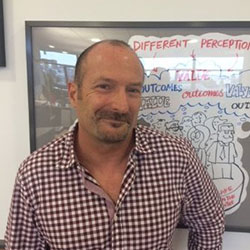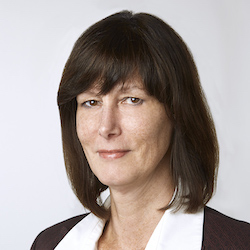“We are now marketers in a data-driven world,” says Steve Mason, Multichannel and Marketing Cloud Expert at Salesforce. His epochal address, aimed squarely at the pharma industry during eyeforpharma’s Marketing and Customer Innovation event last year, could not have been clearer: get digitally savvy or get left behind.
It’s an unassailable argument. Strides in digital innovation have redefined the ways we organise our time and space. The proliferation of digital channels – combined with the free flow of information readily available – has made the customer experience more integrated and personalised than ever before.
Yet despite the material impact digital gains are having on the customer experience, pharma has been notoriously slow on the uptake compared to other industries, says Mason.
What is driving this gap? What must the industry do to stake a claim in this space before it’s too late?
Deb Furey, SVP Strategy and Analytics at Wunderman Health, believes pharma companies should recognize that customer expectations of them are no different than they are from companies such as Spotify, which focus on being an integral part of a customer’s day, providing an indispensable service. Pharma companies can compete in this space by truly understanding how to impact customers experience – seamlessly helping customers find needed resources, serve patients and navigate the challenging access environment, she says.
However, the challenge is not insignificant. “On the one hand, you've got executional challenges like getting the data, the insights, and the direct connections to customers digitally, but I think the bigger challenge is the organisational, which is how do you break down some of the silos that are in some sense working towards different ends – it truly requires a shared vision.”
For Rebecca Joslin, Head of Customer Experience Strategy at Shire, pharma currently poses no credible competition to those in the digital sphere because “we have all worked in pharma for so long, we are always looking for people with pharma experience and we are really missing out on those people that come from the consumer world who have these high expectations of customer service.”
 Pharma’s red tape also impedes progress, she says. “We hide behind this very complex, regulatory environment that we work within and think that everything is a little bit too hard and we don't push and try and achieve the best experience for our patients because it is time-consuming and difficult at the various early stages within a company's progression in this area.”
Pharma’s red tape also impedes progress, she says. “We hide behind this very complex, regulatory environment that we work within and think that everything is a little bit too hard and we don't push and try and achieve the best experience for our patients because it is time-consuming and difficult at the various early stages within a company's progression in this area.”
Philippe Kirby, Director of Customer Engagement Capabilities at MSD, acknowledges that pharma is embarking on a “digital transformation”, but he is reluctant to use the term as it could potentially divert our attention from seeing the bigger picture, he says. “We should be thinking more about marketing transformation since that is at the forefront of driving a customer experience rather than only digital transformation.”
For Kirby, educating marketing professionals on the possibilities afforded by digital will be the key to making headway in this space. You need to first embed it in the culture before you can use the tools, he says.
Assessing the marketing techniques employed by other industries is also a good place to start, Kirby says. “We've definitely been focusing on different ways of doing marketing, starting to understand what Facebook is doing, what Google is doing to interact with people and influence them.”
Mason also chimes with the view that culture is the biggest catalyst for change. For pharma to reform its digital strategy and exploit the “explosion of channels” available, it must widely adopt a “try and fail fast” philosophy. The prospect of endless paperwork and punitive measures can keep companies stagnant. Embedding a framework that facilitates a speed of innovation and fast failure enables marketeers to bounce back quickly and learn from their errors, continuously improving the customer experience, he says.
Joslin shares the sentiment that greater internal awareness and understanding is the key to unlocking digitals potential. For her the solution lies in hitting that sweet spot between the “functional and emotional aspects of marketing”. To forge a personal connection with the customer, you must go beyond merely pushing a product’s attributes, you must incorporate insights derived from the patient journey, she says.
Data is becoming the key way to collect these insights; it is the driving force behind marketing transformation says Kirby. It provides a “richness of detail” that can “really enhance an experience as opposed to just trying to invent one so to speak,” he says.
Despite the obvious merits of using data to capture the customer experience, Joslin wonders if people in pharma are really asking the right questions and using the right metrics to optimise its potential.
“Are we actually looking at that website and tracking the experience of our customers that come into the website? How are you tracking them? What is the data? Where are those people coming in from? What are we expecting the conversion to be and then what experience are we giving them once they leave that site? What other things can we do to support that customer as an entity?”
 Through disseminating data insights, pharma will also strengthen its relationship with HCP’s, a key player in the customer experience, Kirby says. The opportunity to share insights widely and more affordably is an attractive proposition to the HCP and will have a direct impact on their patient outcomes. “We have become information providers in not just necessarily branded information but also unbranded information,” he adds.
Through disseminating data insights, pharma will also strengthen its relationship with HCP’s, a key player in the customer experience, Kirby says. The opportunity to share insights widely and more affordably is an attractive proposition to the HCP and will have a direct impact on their patient outcomes. “We have become information providers in not just necessarily branded information but also unbranded information,” he adds.
Positioning itself as an “information provider” is also an important step forward for pharma, as it builds trust with a wider community of stakeholders, says Mason. By delivering on more than the sales message, by providing an external support network; pharma reinforces its commitment to improving patient outcomes and its role within the wider healthcare ecosystem, he says.
Sharing information on social media is also a relatively inexpensive but effective way for pharma companies to strengthen their customer experience touchpoints. This is an area Shire has already made movements in with its “rare2ware” initiative on Twitter, connecting people living with rare diseases through patient stories and insights.
The insights derived from social media are in turn having a positive impact on the company, helping them to map a patient’s journey throughout their lives, Joslin says. “We were really so focused on the early stage of diagnosis because that's where treatments decisions are made, that we forgot that these patients are living such long, healthy lives and want to hear from each other.”
Artificial intelligence advancements are another key dimension of digital innovation that could help connect pharma’s stakeholders and improve the customer experience, says Furey. “We are working with some clients right now who are using AI applications to figure out how to pull key insights around patient populations for physicians, to enable them to do live tracking of patient data and create a patient console or platform that the physicians are able to use,” she says. “They can anticipate and almost continually monitor their patients in such a way that the conversations they are having at key moments are very meaningful and enhance their relationship,” she says.
 Progress is afoot in the customer experience space, but much more needs to be done, laments Mason. “We are well behind other industries. If I look at online retailers, online gaming organisations, accommodation and holiday vendors – these organisations have really nailed the mapping and ongoing optimisation of the customer experience and are actively implementing it.”
Progress is afoot in the customer experience space, but much more needs to be done, laments Mason. “We are well behind other industries. If I look at online retailers, online gaming organisations, accommodation and holiday vendors – these organisations have really nailed the mapping and ongoing optimisation of the customer experience and are actively implementing it.”
The tide is turning, however. “I am really enthused that we have a desire to get there and believe that, by focusing on innovating around the customer experience, organisations in the industry have an opportunity to stand out. Pharma may be behind the curve, but we are starting to see some leading pharma organisations succeed in maximising their customer engagement strategy and leveraging the opportunity to differentiate on customer experience.”
Related Content: Digital: Let Customers Weave Their Own WebsThinking Outside The BoxFrom Push To Pull: The Reinvention Of MarketingCustomer Experience: Through Thick and Thin Précis: When it comes to customer experience in the digital space, pharma is being outpaced and outsmarted. What can the industry do to change the status quo? Premium`: Freemium`: Channels: CommercialTags: Customer ExperienceOriginal Article
Précis: When it comes to customer experience in the digital space, pharma is being outpaced and outsmarted. What can the industry do to change the status quo? Premium`: Freemium`: Channels: CommercialTags: Customer ExperienceOriginal Article


